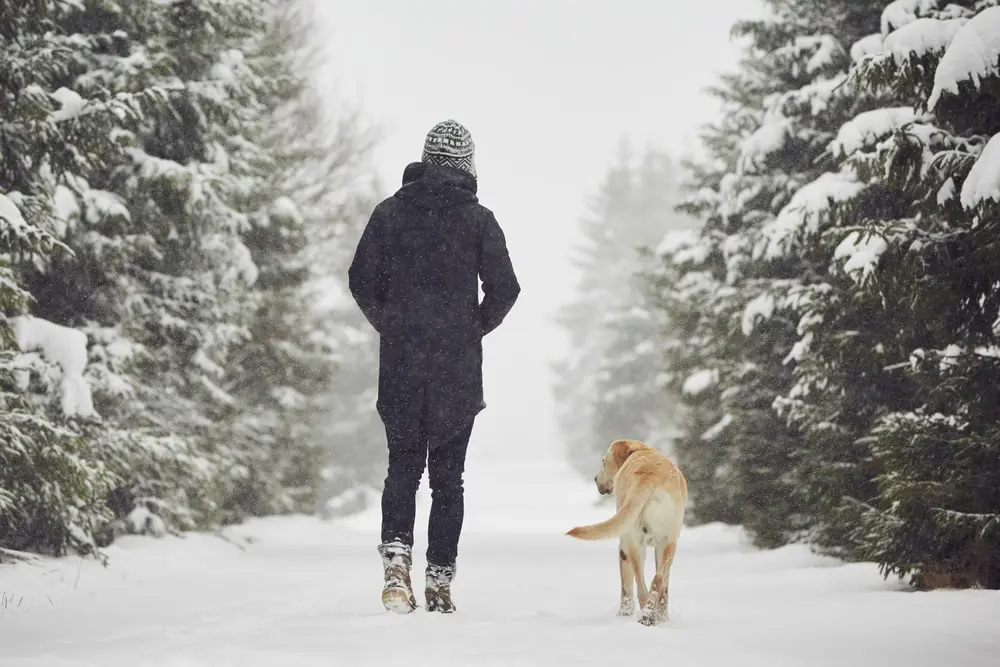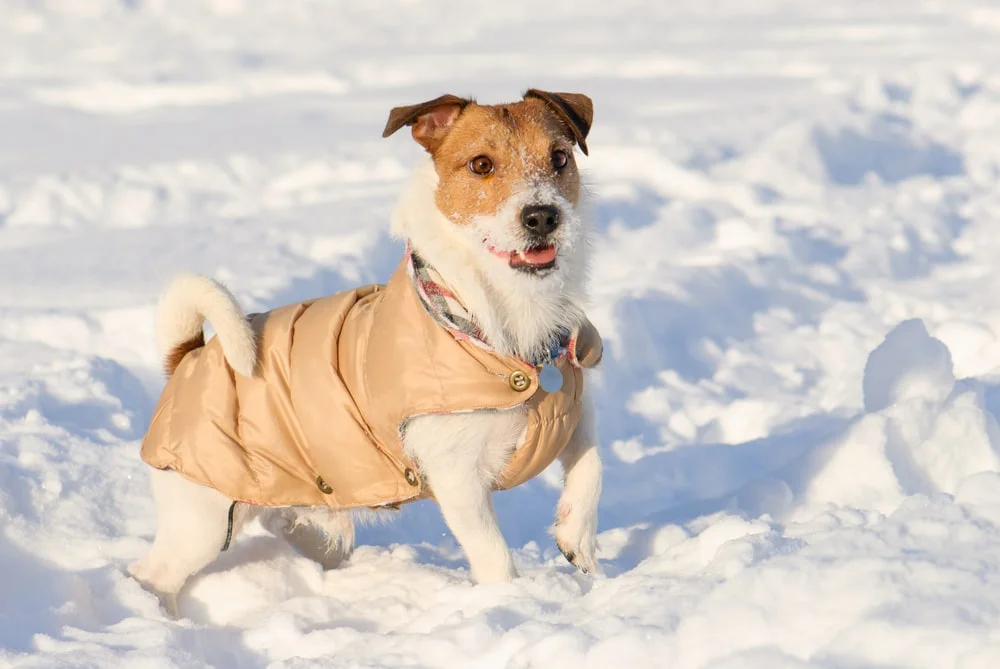PET CARE
Winter Pet Safety Tips
Pet parents may need to take extra steps in the winter to protect their furry family — like wiping paws dry when pets come in from the snow, providing a warm and cozy spot for lounging, or ensuring pets have a safe holiday season. Let’s take a look at some of the ways you can help keep your beloved companions safe during the colder weather months.
Ease Winter Vet Bill Blues With the Help of Pet Insurance
Enroll With MetLife Pet
Keep Pets Away From Toxic Items
Antifreeze and other winter chemicals, like deicers and rock salts, are hazardous to our pets. If your cat or dog ingests toxic items, poisoning symptoms can start quickly and it could lead to death. Be sure all toxic items are sealed tightly and out of reach of both dogs and cats. Check under cars for any antifreeze leaks and be sure to clean them up. It can also be a good idea to avoid letting pets walk where there’s deicer or salts being used.1
If your pet has ingested antifreeze, rock salts, or other toxic items, contact your emergency vet ASAP. You could also call the ASPCA Animal Poison Control Center hotline at (888) 426-4435 or the Pet Poison Helpline at (855) 764-7661 for support.
Clean and Protect Their Paws
Thoroughly clean your pet’s paws and wipe off their legs and stomach when they come in from the sleet, snow, or ice. Salts and bits of snow or ice can irritate pet paws, causing excessive itching or even injury. Pets can also ingest winter chemicals by licking their fur after being outside.1,2
Protecting pet paws can be helpful in preventing poisoning from salts and antifreeze, or injuries due to harsh ground conditions. Older or arthritic dogs may have a harder time walking on slippery ground.1 Try using pet boots or socks when outside. Pet-safe balms can also be applied to paw pads to help protect them from damage.
Watch Out for Frostbite and Hypothermia
Frostbite and hypothermia can be dangerous risks for pets who spend time outside in the cold — and may be one of the most important winter pet safety tips to keep in mind. Monitor the amount of time spent outdoors and, if your pet starts shivering, get them back to a warm place before their health is at risk. Generally, it’s not a good idea for pets to be kept outside in the cold or during inclement weather.1
You may want to get your dog a coat or sweater when they’re outside for a potty break, walk, or playtime to help keep hypothermia at bay. Booties can also protect paws from direct exposure to snow and ice and could help reduce the risk of frostbite.1
Dogs who have short legs, short coats, or certain illnesses — like heart, kidney, and Cushing’s disease, or diabetes — may get colder faster. Puppies and old dogs may also not be able to regulate their temperature well.1,2 Some cold weather dog breeds can withstand winter conditions better than others, but it’s still a good idea to protect them from hypothermia and frostbite.
Signs that it’s too cold outside for your pet
If you’re outside with your pet in the cold for too long, they could become hypothermic. If you notice any of the following signs of hypothermia, bring your pet into a dry, warm place ASAP and contact your vet for next steps:1,2
- Shaking or shivering
- Weakness, lethargy, or slow movements
- Vocalizing
- Anxiety
- Picking paws up off the ground or not wanting to walk
Frostbite typically isn’t noticed until a few days after damage has already started. Some warning signs of frostbite can include:3
- Discolored skin that turns from red, to pale, to bluish black
- Pain or numbness
- Skin blisters or ulcers
- Swelling or cold to the touch
A pet’s paws, toes, nose, ears, and tail are the most susceptible to frostbite, but it can occur anywhere on the body. While this condition is typically treatable, you can spare your pet some discomfort by protecting them from long exposure to cold.3
Plan for Safe Walks and Bad Weather
Shorter winter days might mean darker walks outside for dogs. Use protective clothing to help keep them warm and reflective items or lights to help motorists see you. Steer clear of iced-over bodies of water on your walks — like ponds, creeks, or even puddles — to avoid potentially falling through or slipping.
If there’s bad weather, try skipping the walk and opting for a quick potty time outside instead. Make sure you’re prepared for power outages or being stuck at home with food, water, necessary medications, and a plan to stay warm for you and your pets.
Practice Vehicle Safety
Cold cars can become a danger to pets who are left inside one. Similar to how hot cars can pose a health risk, cold cars can cause your pet’s body temperature to decrease. It’s not a good idea to leave your pet alone in a cold car.1
During the winter, outdoor cats sometimes sleep under the hoods of vehicles or on top of tires. When the motor starts, a cat can be injured. If there are outdoor cats in your area, check under the hood or around your car before starting the engine, or driving off, to give the cat a chance to escape.
Be Careful With Heat Sources
Lighting a fire or plugging in a space heater can help keep rooms warm when it gets chilly. This may bring out your pet’s curiosity. Keep them a safe distance from open flames, wood and pellet stoves, electrical fireplaces, and space heaters, or create a barrier so pets can’t get too close.
Don’t leave your pet alone with these heat sources either — especially space heaters that can be knocked over and become a potential burn or fire hazard. Instead, fix your pet an extra warm space with a bed and blankets to help keep the chill of winter to a minimum.
Avoid Holiday Mishaps and Dangers
Winter is a jam-packed holiday season — with many celebrations like Christmas, Hanukkah, New Year’s Eve, and more. Keep the following tips in mind to help ensure your furry family is enjoying the festivities alongside you.
Keep pet-safe decorations in mind
Decorating can be one of the best parts of the holiday season. But many decorations can look like fun toys or treats to pets. If you’re decking the halls with holly, candles, ornaments, string lights, real trees, wreaths, garland, tinsel, ribbon, and more, it’s a good idea to keep them out of your pet’s reach or opt for pet-safe options.4
Some decorations may cause poisoning. Others could cause burns, choking, or lead to intestinal blockages. Keep a watchful eye on your pet to avoid illness or injury.4
Watch pets around presents
Winter celebrations can sometimes come with gift-giving. Wrapping paper, tags, and ribbons can become choking hazards if pets get ahold of them. Presents that have small parts could also cause choking or intestinal blockages if pets try to eat them. It may be a good idea to provide your pet with their own presents, toys, or treats to keep them occupied and away from potential dangers.
Know which holiday foods can make pets sick
While certain holiday foods can be a treat for us, they can pose health risks for pets. Chocolate, candy, foods that contain the sweetener xylitol, garlic and onions, yeast dough, grapes, and other human foods can be toxic to pets. Some may cause poisoning, while others might create gastrointestinal issues. Even pet-safe foods like turkey, potatoes, or fish could be dangerous for pets if they have seasonings on them.4
When it comes to holiday treats, it’s a good idea to skip the table scraps and give your cat or dog a pet-safe treat made just for them. And keep a watchful eye out for pets who want to sneak a taste when you’re preparing food or hosting gatherings.
Reduce pet stress during gatherings and holiday travel
Not all pets like parties or having lots of new people in their home. The noise, movement, and break in their routine can cause stress or anxiety, not to mention the potential for bolting outside. It might be a good idea to keep pets in a separate, safe, and calm environment during parties to help reduce anxiety or avoid accidental escapes. Tell your guests you have pets and where they’ll be, so party-goers are aware and can take any necessary precautions.
Holiday gatherings may also come with the need to travel — with or without your pet. If you’re traveling with your pet, keep them secure, take everything they need, and ensure they’re healthy enough to travel. You might need to bring their vet records with you or get a health certificate, depending on travel regulations.4
If you’re traveling without your pet, look to a trusted friend, family member, or pet sitter to watch your companion. You could also consider a boarding facility. Make sure your pet is up-to-date on all their vaccinations, and provide care instructions and vet or emergency numbers so their temporary caretaker is prepared.
If Your Pet Needs a Vet, MetLife Pet Can Help You With the Bill
Winter may be considered a wonderful time of year to some, but it can come with potential risks for our furry friends. By keeping these winter safety tips for pets in mind, you can help ensure your dog or cat has a cozy, fun-filled time with you.
In the event your pet has an accident or gets sick, MetLife Pet Insurance can help. With up to 90% reimbursements on covered costs like X-rays, vet exams, diagnostics, surgeries, and more, you can focus on getting your pet back in good health rather than the cost of vet bills.5 Enroll your furry family today, starting with a free quote.



